1928. Willem Mengelberg (1871-1951) in New York with the New York Times.
- Profession: Conductor, composer.
- Residences: Amsterdam.
- Relation to Gustav Mahler (1860-1911): Amsterdam Royal Concertgebouw Orchestra (RCO). Friend. Mahler was deeply impressed by Willem Mengelberg (1871-1951)‘s ability to empathize with his music. Promotor. At the rehearsals that Mahler led, Mengelberg wrote down in his score all kinds of remarks that the composer made to the orchestral musicians. Mengelberg wrote notes on “Spitzentechnik” on the front cover of the score of Symphony No. 5, a technique for the strings, writes Mengelberg, which must be used in all symphonys of Mahler, and of which it is important that all strings do this. His notes to Movement 4: Adagietto. Sehr langsam are the key to a good understanding of the music.
- Relation to Gustav Mahler (1860-1911): Gustav Mahler Festival Amsterdam 1920.
- Relation to Richard Strauss (1864-1949): Supporter and friend of Strauss. Often invited him to Amsterdam. Richard Strauss for the first time in Amsterdam on 05-10-1904.
- Relation to Alphons Diepenbrock (1862-1921): Friend.
- Correspondence with Mahler: Yes.
- Born: 28-03-1871, Utrecht, The Netherlands. His father was the well-known Dutch-German sculptor Friedrich Wilhelm Mengelberg (1837-1919).
- Education: Franz Wullner (1832-1902). Wullner led the premieres of Richard Wagner’s operas Das Rheingold and Die Walküre, but was much criticized by Wagner himself, who greatly preferred the more celebrated conductors Hans von Bülow and Hermann Levi.
- Engaged: 08-05-1898 Mathilde Mengelberg-Wubbe (1875-1943).
- Married: 05-07-1898 Mathilde Mengelberg-Wubbe (1875-1943).
- No children, weak health, awkward in the financial field.
- Died: 22-03-1951 Zuort, Sent, Switzerland. Chasa Mengelberg. Inflammation lungs. Aged 79.
- Buried: 28-03-1951 Friedental cemetery, Luzern, Switzerland. On the day he would have been 80 Mengelberg was buried at Friedhof Friedental (his wife Mathilde Mengelberg-Wübbe rested here since 1943) in Luzern, where he started his musical career in 1892. A year later (07-06-1952) the couple was reburied; from a rather impersonal ‘Hallengrab’ (HF 504 and 505) to a more personal place (no. 1323, box 36).
The Gustav Mahler (1860-1911) pioneer in Amsterdam and New York
Willem Mengelberg, conductor of the Amsterdam Royal Concertgebouw Orchestra (RCO), was grasped by Gustav Mahler’s music when he attended 1902 Concert Krefeld 09-06-1902 – Symphony No. 3 (Premiere). Right from that moment, he vigorously took on promoting Mahler’s music, claiming Mahler to be ‘the Beethoven of his time’. In his persistent efforts to introduce Mahler’s music, Mengelberg gradually acquired an outstanding position both in The Netherlands and in Europe, in this respect leaving behind other contemporary conductors.
Time and again, Mengelberg tried to persuade Mahler to conduct his own works in Amsterdam. See Gustav Mahler himself in the Netherlands (1903, 1904, 1906, 1909 and 1910). During these visits, the composer was staying with the Mengelbergs at their home (House Willem Mengelberg). However, because of his numerous engagements elsewhere, Mahler was often compelled to decline Mengelberg’s invitations for conducting.
Mengelberg’s commitment to promote Mahler’s music should not be underestimated. At the time, a substantial part of the public would leave the concert hall to demonstrate their disapproval of Mahler’s music, which was, on top of that, often ridiculed by the critics. Mengelberg was convinced of Mahler’s genius, which inspired him to persist in his dogged endeavours, taking for granted that this implied rowing against the stream. Only after years of sustained perseverance, a ‘Mahler community’ came into existence in The Netherlands, which formed the basis of the unprecedented success of the Gustav Mahler Festival Amsterdam 1920, drawing worldwide attention. In the 1920’s, Mengelberg, who had by then also become conductor of the New York Philharmonic Orchestra (NYPO/NPO), repeated his efforts to promote Mahler’s music to the American public.
Mengelberg was one of the most important Mahler pioneers who deserves a special place of honour in our remembrance. His tireless efforts to make Mahler’s music better known to a greater public contributed greatly to the international Mahler culture of this era.
The Willem Mengelberg’s archives in the Netherlands Music Institute contain, amongst other things, his conducting scores, which are characterized by his colourful annotations that clearly indicate his conductors interpretation of the work concerned. In addition, many of these scores also contain instructions and remarks of Mahler himself: tangible and visible evidence of the close ties between Willem Mengelberg and Gustav Mahler.
Relevant
- House Willem Mengelberg.
- Gustav Mahler himself in the Netherlands (1903, 1904, 1906, 1909 and 1910).
- Zuiderzee (1906).
- Moors between Hilversum and Laren (1906).
- Gustav Mahler Festival Amsterdam 1920.
Manuscripts of Gustav Mahler
- 1917: Facsimile Manuscript Das Lied von der Erde, Lied 6: Der Abschied: Given by Alma Mahler (1879-1964) on the occasion of Willem Mengelberg (1871-1951)‘s debut in Vienna with the Vienna Philharmonic Orchestra (VPO). Two manuscripts (Partiturenentwurf and Clavierauszug), both studies. In 2002 publication of the first manuscript, a facsimile of the Clavierauszug (piano extract). Publication of both in 2017.
- 1920: Fair copy of Manuscript Symphony No. 7. Given by Alma Mahler (1879-1964) at Gustav Mahler Festival Amsterdam 1920. Published in 1995.
Addresses
- Roemer Visscherstraat 2, Amsterdam. Arranged by Van Rees. Too expensive.
- Parkzicht complex, corner Hobbemakade, Amsterdam. Etage. Arranged by Charles Ernest Henri Boissevain (1868-1940). Two piano’s.
- 1900: House Willem Mengelberg, Van Eeghenstraat 107 and 105, Amsterdam. Gustav Mahler (1860-1911) stayed here. Since 1932 he did not live here anymore because of tax issues. Lived in Amstel Hotel.
- 1920-1951: Zuort, Sent, Switzerland. Chasa Mengelberg. See photos on this page.
- 1932: Amsterdam, Amstel Hotel. Professor Tulpplein 1, Amsterdam.
Joseph Willem Mengelberg was a Dutch conductor, famous for his performances of Mahler and Strauss with the Concertgebouw Orchestra. Mengelberg was the fourth of fifteen children of German-born parents in Utrecht, Netherlands. His father was the well-known Dutch-German sculptor Friedrich Wilhelm Mengelberg.
After studies in Utrecht with the composer and conductor Richard Hol, the composer Anton Averkamp (1861-1934) and the violinist Henri Wilhelm Petri (1856-1914), he went on to study piano and composition at the Cologne conservatory (now the Hochschule für Musik Köln), where his principal teachers were Franz Wüllner, Isidor Seiss and Adolf Jensen.
In 1891, when he was 20, he was chosen as General Music Director of the city of Luzern Switzerland, where he conducted an orchestra and a choir, directed a music school, taught piano lessons and continued to compose. Four years later, in 1895, when he was 24, Mengelberg was appointed principal conductor of the Concertgebouw Orchestra, a position he held until 1945.
Year 1895. 24-10-1895. Last concert Willem Kes (1856-1934) and debut Willem Mengelberg (1871-1951) with the Amsterdam Royal Concertgebouw Orchestra (RCO) in the Amsterdam Royal Concertgebouw.
In this position, Mengelberg was to premiere a number of masterpieces. For example, in 1898, Richard Strauss dedicated his tone poem Ein Heldenleben to Mengelberg and the Concertgebouw Orchestra, telling journalists that he “had at last found an orchestra capable of playing all passages, so that he no longer needed to feel embarrassed when writing difficulties.” Among other notable premieres were those on March 29, 1939, when Mengelberg conducted the premiere of the Violin Concerto no. 2 by Béla Bartók with violinist Zoltán Székely, and on November 23, 1939, he premiered the Peacock Variations of Zoltán Kodály.
Mengelberg founded the long-standing Mahler tradition of the Concertgebouw. He met and befriended Gustav Mahler in 1902, and invited Mahler to conduct his Third Symphony in Amsterdam in 1903; and on October 23, 1904, Mahler led the orchestra in his Fourth Symphony twice in one concert, with no other work on the program. Mahler wrote to his wife Alma Mahler that this programming idea (presumably Mengelberg’s) was a “stroke of genius.”
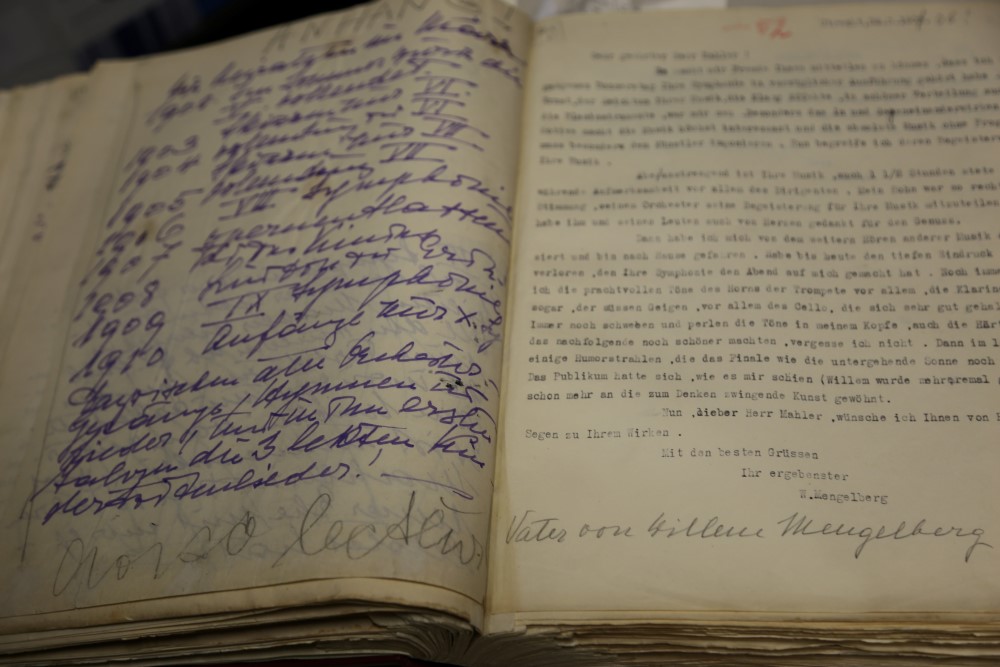
Year 1903. Probably 24-10-1903 (and not 24-03-1904): Utrecht, Netherlands. Letter by Friedrich Wilhelm Mengelberg (1837-1919), father of Willem Mengelberg (1871-1951) to Gustav Mahler (1860-1911). 1940 (published). Alma Mahler (1879-1964): “Gustav Mahler: Erinnerungen and Briefe“. Published by Allert de Lange, Amsterdam. About concert 1903 Concert Amsterdam 22-10-1903 – Symphony No. 3. Left side: Remarks Alma Mahler. Page 262 in print. Médiathèque Musicale Mahler.
Year 1903. 25-10-1903 Registration Gustav Mahler (1860-1911) in guest book Willem Mengelberg (1871-1951).
Year 1903. Postmark 01-11-1903. Vienna State Opera. Letter by Gustav Mahler (1860-1911) to Willem Mengelberg (1871-1951) in which Mahler calls Amsterdam his second ‘Homeland’.
Mahler regularly visited The Netherlands to introduce his work to Dutch audiences, including also his First, Fifth, and Seventh Symphonies, as well as Das klagende Lied and Kindertotenlieder. Mahler edited some of his symphonies while rehearsing them with the Concertgebouw Orchestra, making them sound better for the acoustics of the Concertgebouw. This is perhaps one reason that this concert hall and its orchestra is renowned for its Mahler tradition. In 1920, Mengelberg instituted a Mahler Festival in which all the composer’s music was performed in nine concerts.
Envelope letter Gustav Mahler (1860-1911) to Willem Mengelberg (1871-1951). Source: Archives of Willem Mengelberg, Netherlands Music Institute / The Hague Municipal Archives.
00-08-1906, Year 1906. Maiernigg am Worthersee. Letter sent by Gustav Mahler (1860-1911) to Willem Mengelberg (1871-1951). About Symphony No. 6 and Symphony No. 8. This section is about Symphony No. 6. Source: Archives of Willem Mengelberg, Netherlands Music Institute / The Hague Municipal Archives.
00-08-1906, Year 1906. Maiernigg am Worthersee. Letter sent by Gustav Mahler (1860-1911) to Willem Mengelberg (1871-1951). About Symphony No. 6 and Symphony No. 8. Conclusion in which he writes about the ‘many notes’ in his Symphony No. 8. Last page. Signature. Source: Archives of Willem Mengelberg, Netherlands Music Institute / The Hague Municipal Archives.
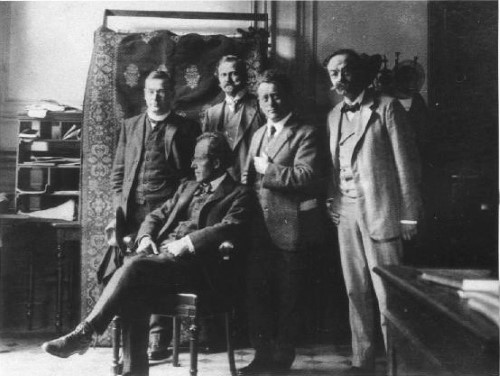
Year 1909. 113. 1909. Amsterdam. Concertgebouw. Gustav Mahler (1860-1911) with Dutch colleagues: From left to right: Cornelis Dopper (1870-1939) (second conductor of the Royal Concertgebouw Orchestra (RCO)), Gustav Mahler (1860-1911), Hendrik Freijer (1876-1955) (administrator of the Royal Concertgebouw Orchestra (RCO)), Willem Mengelberg (1871-1951) (principal conductor of the Royal Concertgebouw Orchestra (RCO)) and Alphons Diepenbrock (1862-1921) (composer). Photographer: W.A. van Leer for “Weekblad voor muziek”. The Netherlands.
Score of Symphony No. 7 owned by Willem Mengelberg (1871-1951). Frontispice to a design of Alfred Roller (1864-1935). Score for private use only. A frontispiece is an illustration facing a book’s title page. Source: Archives of Willem Mengelberg, Netherlands Music Institute / The Hague Municipal Archives.
04-04-1912. Alma Mahler (1879-1964) and Willem Mengelberg (1871-1951) in Frankfurt am Main, Germany. See Gustav Mahler legacy. Source: Archives of Willem Mengelberg, Netherlands Music Institute / The Hague Municipal Archives. Taken from the biography of Willem Mengelberg (part I) by Frits Zwart.
09-03-1912 Amsterdam: Amsterdam Royal Concertgebouw Orchestra (RCO), Willem Mengelberg (1871-1951), Dutch premiere of Symphony No. 8. Version 1906. Gertrude Forstel (1880-1950), Emma Bellwidt (1879-1937), Ottilie Metzger-Lattermann (1878-1943), Anna Erler-Schnaudt (1878-1963), Felix Senius (1868-1913), Nicola Geisse-Winkel (1872-1932), W. Femten, Toonkunst choir. 09-03-1912 Vienna: On behalf of Willem Mengelberg (1871-1951) and the Toonkunst choir, a wreath is laid on Mahler’s Grave by the Dutch consul Rive.
1913. 27-04-1913. Willem Mengelberg (1871-1951) serving Richard Strauss (1864-1949) and Gustav Mahler (1860-1911) on his American tour.
24-06-1915. Willem Mengelberg (1871-1951) to Arnold Josef Rose (1863-1946) from the Amsterdam Royal Concertgebouw, filed 09-07-1915: The Concertgebouw Orchestra needs a first horn player with a good sound for Mahler. Can Rosé help? Mengelberg mentions the past season’s Mahler performances: Symphonies 1, 2, 3, 4, 7; Das Lied von der Erde; Das klagende Lied; Kindertotenlieder; and various orchestral lieder.
24-06-1915. Willem Mengelberg (1871-1951) to Arnold Josef Rose (1863-1946).
Mengelberg was music director of the New York Philharmonic Orchestra from 1922 to 1928. Beginning in January 1926, he shared the podium with Arturo Toscanini; Toscanini biographer Harvey Sachs has documented that Mengelberg and Toscanini clashed over interpretations of music and even rehearsal techniques, creating division among the musicians that eventually resulted in Mengelberg leaving the orchestra.
However, the maestro did make a series of recordings with the Philharmonic for both the Victor Talking Machine Company and Brunswick Records, including a 1928 electrical recording of Richard Strauss’ Ein Heldenleben that was later reissued on LP and CD. One of his first electrical recordings, for Victor, was a two-disc set devoted to A Victory Ball by Ernest Schelling (friend of Mengelberg in New York, composer and piano player).
Mengelberg was described by Fred Goldbeck as “the perfect dictator/conductor, a Napoleon of the orchestra”; Alan Sanders writes, “his treatment of the orchestra was autocratic. In later years his behaviour became extreme, and there are extraordinary stories of abusive verbal exchanges between him and his players at rehearsal”. Berta Geissmar records an incident in 1938 when Mengelberg rehearsed the London Philharmonic Orchestra in the Vorspiel und Liebestod from Tristan and he gave them tortuous lectures as though they had never seen the music before.
The most controversial aspect of Mengelberg’s biography centers on his actions and behavior during the years of the Nazi occupation of Holland between 1940 and 1945. His biographer Fritz Zwart writes (for Radio Nederland) of an “interview Mengelberg had given with the Völkische Beobachter, the German Nazi newspaper…the gist of it was that, on hearing of the Dutch surrender to the German invaders on May 10, 1940, he had brought a toast with a glass of champagne and had also spoken about the close bond existing between the Netherlands and Germany.”
Zwart also notes that Mengelberg conducted in Germany and in German-occupied countries throughout the war, and was photographed in the company of Nazis such as Arthur Seyss-Inquart. Explanations have ranged from political naiveté in general, to a general “blind spot” for criticism of anything German, given his own ancestry.
After the war, in 1945, the Netherlands’ Honour Council for Music banned him from conducting in the Netherlands for life; in 1947, after an appeal by his lawyers, the Council reduced his ban to six years, though also in 1947, Queen Wilhelmina withdrew his Gold Medal of Honor.
This notwithstanding, he continued to draw a pension from the orchestra until 1949 when cut off by the city council of Amsterdam. Mengelberg retreated in exile to Zuort, Sent, Switzerland, where he remained until his death in 1951, just two months before the expiration of his exile order. Willem Mengelberg was the uncle of the musicologist and composer Rudolf Mengelberg and of the conductor, composer and critic Karel Mengelberg, who was himself the father of the improvising pianist and composer Misha Mengelberg.
Performance style
Mengelberg’s recordings with the Concertgebouw Orchestra are marked by frequent use of an unusually prominent portamento, the sliding of the string players’ left fingers from one note to another. The scholar Robert Philip has shown that Mengelberg’s recordings with other orchestras do not show this portamento, and that “the unusual approach to portamento… was a stylistic feature which he developed with the Concertgebouw over a long period of rehearsal, and that it was not a style which could be transferred to other orchestras when Mengelberg visited them” .
Philip also notes that this portamento required the strings to use uniform fingering prescribed by Mengelberg, and that this was also unusual for the time, when much orchestral fingering was typically “free,” with different players fingering a passage differently. Freely bowed portamento sounded lighter than that we hear in Mengelberg’s recordings, as not all players would slide on the same notes. Philip mentions recordings by the Vienna Philharmonic under Bruno Walter as examples of this style.
07-06-1916 Letter by Alma Mahler (1879-1964) to Willem Mengelberg (1871-1951)
Eben kommen alle Programme (aus Amsterdam) an. Das ist ja fabelhaft! – Ja Gustav hat an Ihnen den Freund, den er immer in Ihnen sah – Wenn er das nur erleben konnte! – Aber Sie sind einer der seltesten Menschen – die Ihm auch bei Lebzeiten Liebe und tiefstes Verstandnis gegeben haben. Denn aber was sich “heute” alles sein Freund nennt – tot mir Weh … Heute ist es leicht.
All programs (from Amsterdam) have arrived. This is fabulous! – Yes, you are Gustav’s friend he always thought you were – If only he could see it! – You are very special and gave him love and deepest understanding during his lifetime. If one sees who is calling him friend now – it hurts me … today it is easy.
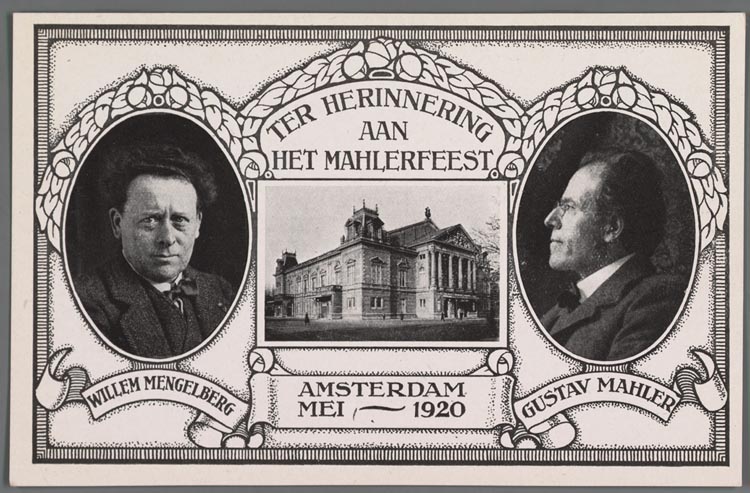
1920. Willem Mengelberg (1871-1951). To commemorate the Gustav Mahler Festival Amsterdam 1920.
In addition, Mengelberg employed fluctuations of tempo that were extreme even in an era in which tempo fluctuation was more common than in modern practice. While admirers of Mengelberg value his tempo inflections, detractors have criticized them.
For example, the musicologist and music theorist Walter Frisch has argued that “in the Brahms performances recorded by Willem Mengelberg, tempo fluctuation too often tends to obscure the broader shape of a passage or movement.” Frisch argues that this obscuring of structure does not result from the tempo fluctuations of two conductors he admires who also used much tempo inflection, Wilhelm Furtwängler and Hermann Abendroth.
Chasa Mengelberg (1911-1951)
The Chasa Mengelberg is a chalet that Willem Mengelberg had built at the beginning of the 20th century in the Lower Engadine valley in the Canton of Grisons, Switzerland. Mengelberg stayed there especially during holidays and regularly received (distinguished) guests.
The wish of the chief conductor of the Concertgebouw Orchestra Willem Mengelberg to build his own house is from the summer of 1910. As usual he stayed in Switzerland to cure and enjoy nature. In 1911 the construction of his Chasa was started, which he himself had designed. He had retained that skill in the training his father, the artist Friedrich Wilhelm (1837-1919), had given him in his studio. His father designed and built, among other things, some parts of the Cologne Dom.
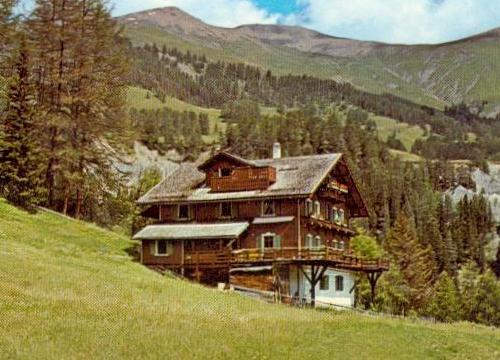
Chasa Mengelberg. Exterior.
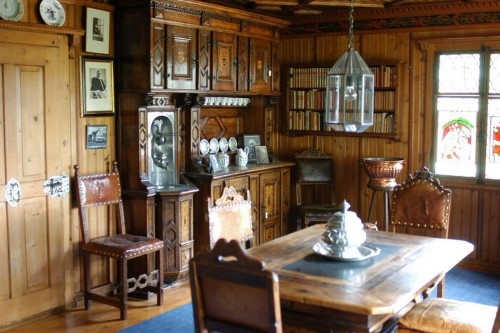
Chasa Mengelberg. Interior.
The Chasa was built in stages. It was not until 1922 that the Chasa was ready in its present size. In the first year the construction work began with the ground floor and the basement. In 1912 there was a floor with the guest rooms. From 1914 it was ready to receive guests. In the winter of 1915-1916 Mengelberg’s own floor was added. There he had his own bedroom, a small balcony and a private bathroom with bathtub.
In the bedstead is the compound skin under which Mengelberg died. A housekeeper found him in a coma one week before his eightieth birthday. In the cupboard are Ichthyol pills, stretch bandage, a rubber blower, wafers, and the masters’ hats, including the felted copy with which he once had himself photographed with a locomotive as a metaphor of the supreme operator.
Even after his death, the guesthouse had a ‘flowering time’. Bernard Haitink (1929) and Kondrashin were there. Electricity came in 1985.
The handwriting of Mahler’s Second Symphony, a gift from Mahler’s widow to Mengelberg, was sold to the American Gilbert Kaplan for maintenance of the Chasa. See Manuscript Symphony No. 2. To the horror of Dutch music historians, Mahler enthusiasts and staff of the Gemeentemuseum, the Mengelberg Stiftung also brought the manuscripts of Mahler’s Totenfeier and Lieder eines fahrenden Gesellen with other valuables to the London auction a few years later.
11-04-1925. Willem Mengelberg (1871-1951), Carnegie Hall, New York Philharmonic Orchestra (NYPO/NPO). St Mattew Passion. Source: Archives of Willem Mengelberg, Netherlands Music Institute / The Hague Municipal Archives. Taken from the biography of Willem Mengelberg (part II) by Frits Zwart.
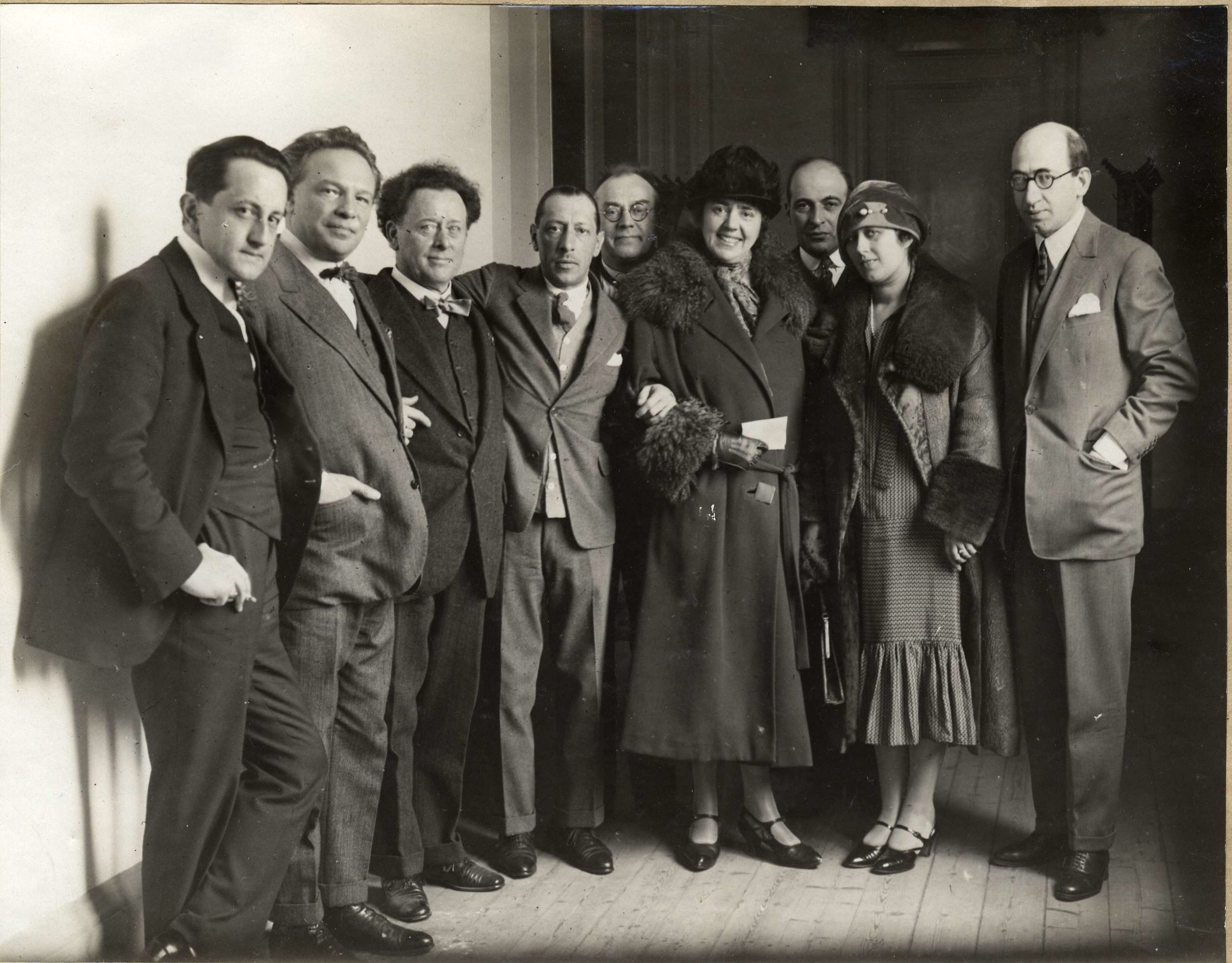
1926. Rudolf Mengelberg (1892-1959), Ottorino Resphighi, Willem Mengelberg (1871-1951), Igor Stravinsky (1882-1971), Cornelis Dopper (1870-1939), mrs. Mathilde Mengelberg-Wubbe (1875-1943), Sam Bottenheim, mrs. Lourié and Arthur Lourié.
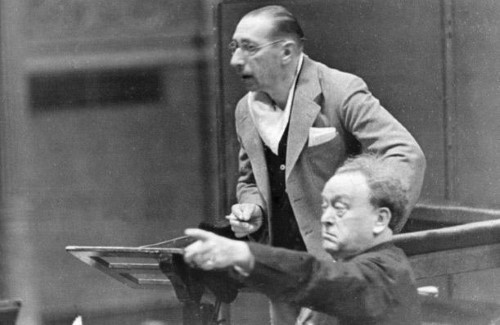
1926. Willem Mengelberg (1871-1951) and Igor Stravinsky (1882-1971).
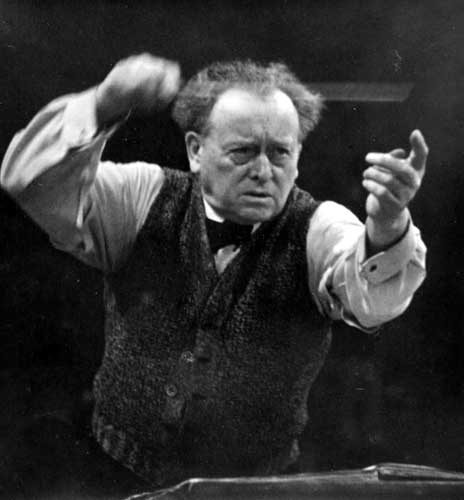
Willem Mengelberg (1871-1951).
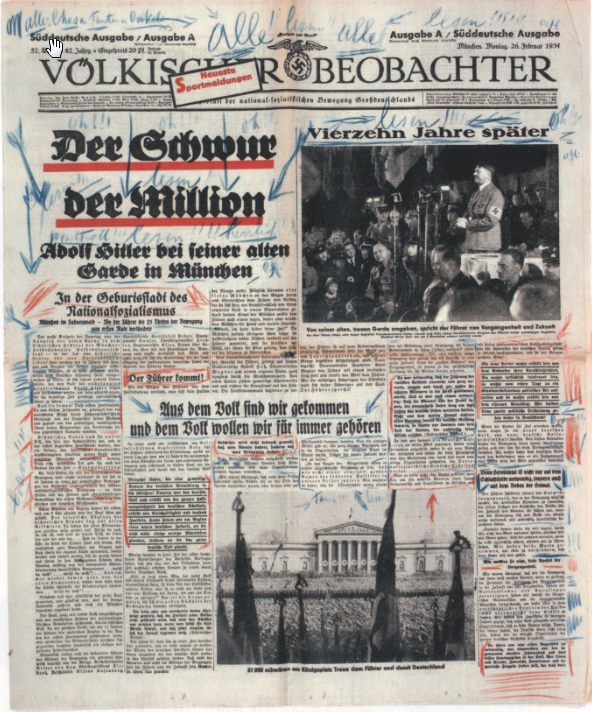
26-02-1934. Volkischer Beobachter. With notes from Willem Mengelberg (1871-1951). He wrote: “Read everything, beautiful, gorgeouis”. Source: Archives of Willem Mengelberg, Netherlands Music Institute / The Hague Municipal Archives. Taken from the biography of Willem Mengelberg (part II) by Frits Zwart.
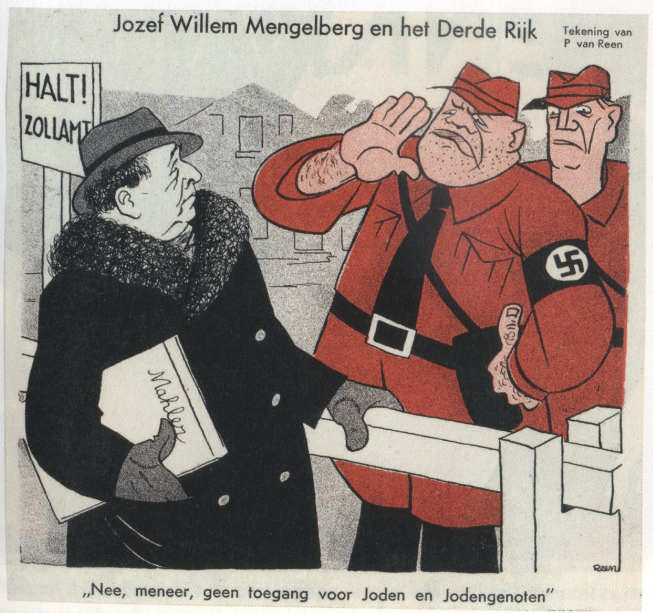
11-1935: Josef Willem Mengelberg and the Third Reich. “No sir, no access for Jews and Jew-lovers”. Source: Archives of Willem Mengelberg, Netherlands Music Institute / The Hague Municipal Archives. Taken from the biography of Willem Mengelberg (part II) by Frits Zwart.
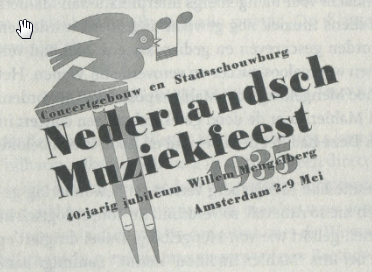
1935. Dutch Music Festival. Willem Mengelberg (1871-1951). Dutch Music Festival (Nederlands/Nederlandsch Muziekfeest). 02-05-1935 until 19-05-1935. Dutch composers. On the occasion of the 40-year collaboration of Mengelberg with the Amsterdam Royal Concertgebouw Orchestra (RCO). Performances of Alphons Diepenbrock (1862-1921)‘s Te Deum and Electra (performed by the Diepenbrock daughters in the small hall). Afterwards a visit to House Diepenbrock. Willem Mengelberg (1871-1951) had not been there since 1921 because of an argument. 11-05-1935. Musical homage to Willem Mengelberg, standing on the platform of the Amsterdam Amstel Hotel. Dinner in Amstel Hotel. Awards. One of the presents was a car (Minerva 40 C) that replaced the Minerva he got in 1931. Fireworks. Painting made by Antoon van Welie (1866-1956).
1935. Willem Mengelberg (1871-1951) and his new Minerva. In front of the artist entry of the Amsterdam Royal Concertgebouw.
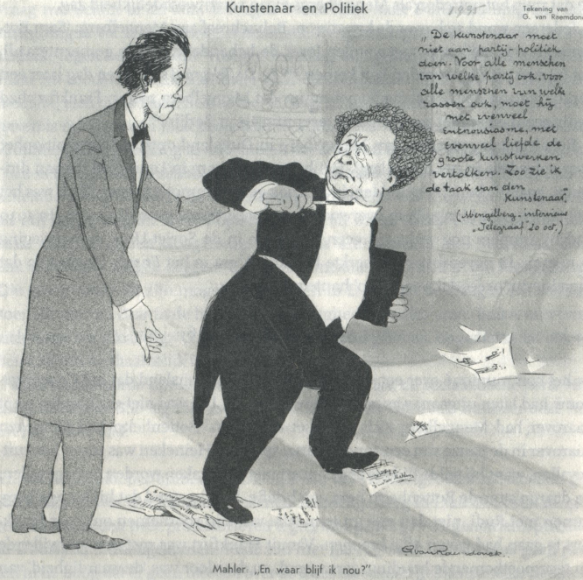
20-10-1935. Artist and Politics. Drawing by G. van Raemsdonck with a interview in the Dutch newspaper The Telegraaf on 20-10-1935. Source: Archives of Willem Mengelberg, Netherlands Music Institute / The Hague Municipal Archives. Taken from the biography of Willem Mengelberg (part II) by Frits Zwart.
Dutch: Mahler tegen Mengelberg: “En waar blijf ik nou?”. Interview Mengelberg: “De kunstenaar moet niet aan partij-politiek doen. Voor alle mensen van welke partij ook, voor alle mensen van welke rassen ook, moet hij met evenveel enthousisme, met evenveel liefde de grote kunstwerken vertolken. Dat is de taak van de kunstenaar.”
English: Gustav Mahler (1860-1911) to Willem Mengelberg (1871-1951): “And where do I stay?”. Interview Mengelberg: “The artist must not be involved in party politics. For all people of any party, for all people of any race, he must express the great works of art with equal enthusiasm, with equal love. That is the artist’s job.”
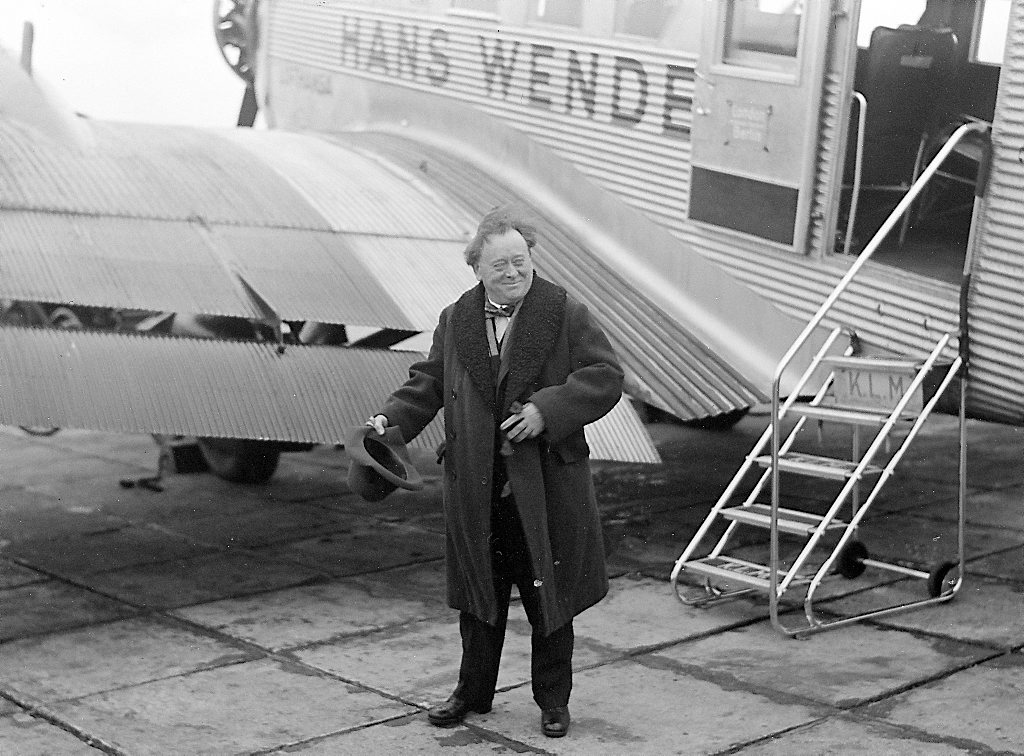
05-11-1936: Stopover Willem Mengelberg (1871-1951) at Schiphol on his (first) flight. He travelled from London to Berlin.
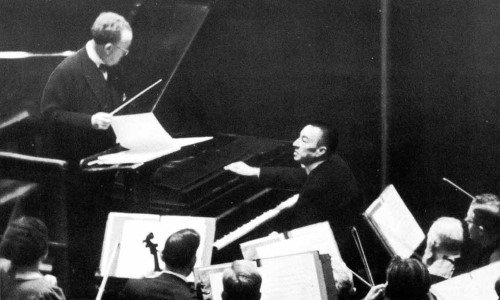
1938. Willem Mengelberg (1871-1951) and Sergei Rachmaninoff (1873-1943).
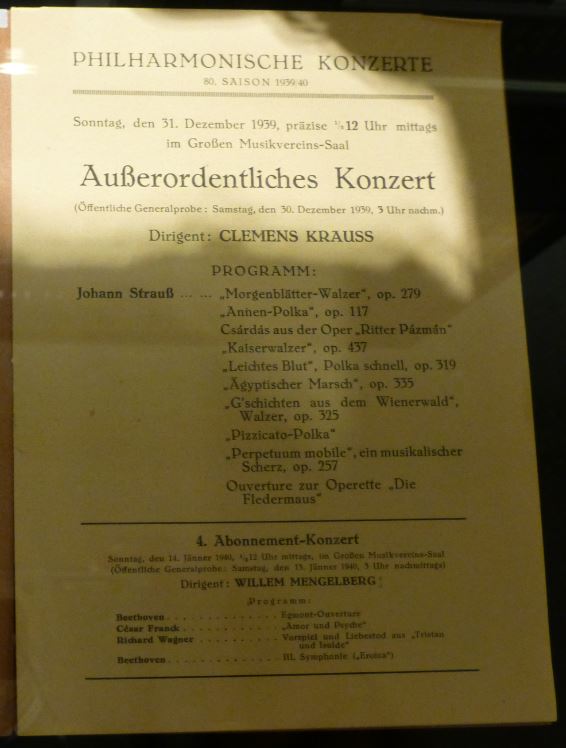
14-01-1939. Willem Mengelberg (1871-1951) in the Gesellschaft der Musikfreunde.
26-10-1940. The Hague. Last time Willem Mengelberg (1871-1951) conducted a composition by Gustav Mahler (1860-1911).
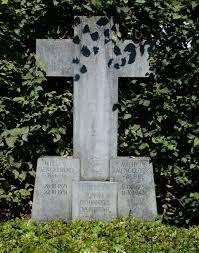
1951. Willem Mengelberg (1871-1951) grave. 28-03-1951 Friedental cemetery, Luzern, Switzerland. On the day he would have been 80, Mengelberg was buried at Friedhof Friedental (his wife Mathilde Mengelberg-Wubbe (1875-1943) rested here since 1943) in Luzern. A year later (7 June 1952) the couple was reburied; from a rather impersonal ‘Hallengrab’ (HF 504 and 505) to a more personal place (no. 1323, box 36).
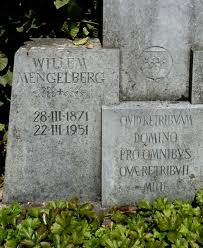
1951. Willem Mengelberg (1871-1951) grave.
Recorded legacy
Some of his performances in Amsterdam were recorded on the innovative German tape recorder, the Magnetophon, resulting in unusually high fidelity for the time. Sound films of Mengelberg conducting the Concertgebouw Orchestra, during live concerts in Amsterdam, have survived. Among these are a 1931 performance of Weber’s Oberon overture and a 1939 performance of Bach’s St Matthew Passion.
His most characteristic performances are marked by a tremendous expressiveness and freedom of tempo, perhaps most remarkable in his recording of Mahler’s Fourth Symphony but certainly present in the aforementioned St Matthew Passion and other performances as well. These qualities, shared (perhaps to a lesser extent) by only a handful of other conductors of the era of sound recording, such as Wilhelm Furtwängler and Leonard Bernstein (1918-1990), make much of his work unusually controversial among classical music listeners; recordings that more mainstream listeners consider unlistenable will be hailed by others as among the greatest recordings ever made.
Many of his recorded performances, including some live concerts in Amsterdam during World War II, have been reissued on LP and CD. While he was known for his recordings of the German repertoire, Capitol Records issued a powerful, nearly high fidelity recording of César Franck’s Symphony in D minor, recorded in the 1940s by Telefunken with the Concertgebouw Orchestra. Due to the Dutch government’s six-year ban on Mengelberg’s conducting activities, he made no more recordings after 1945.
Mengelberg made commercial recordings in the United States with the New York Philharmonic for Victor (1922-1930) and Brunswick (1926-1927). In Amsterdam with the Concertgebouw Orchestra he made a series of records issued in various countries on the Columbia and Odeon labels (1926-32) as well as two works recorded for the Dutch branch of Decca in 1935. Mengelberg recorded with the Concertgebouw Orchestra and the Berlin Philharmonic for Telefunken (1937-1942).
After his death, Philips issued recordings of live performances recorded by Dutch radio services, and these have been reissued by Decca. In addition to his recordings of Richard Strauss’s Ein Heldenleben, Mengelberg left discs of symphonies by Beethoven, Tchaikovski and Brahms, and Bach’s St Matthew Passion.
11-01-2019: Release CD and DVD ‘Selected Compositions’ Willem Mengelberg (1871-1951) on Attacca. Gustav Mahler (1860-1911): ‘I am convinced that what you make, can not be bad’.
Auction 25-03-1952
1952: Auction objects Willem Mengelberg (1871-1951) in the Netherlands in 1952: Auction for 5 days from 25-03-1952 to 30-03-1952 at S.J. Mak van Waay in Amsterdam. Including 145 musical instruments.
25-03-1952 Auction objects Willem Mengelberg (1871-1951). Advertisement.
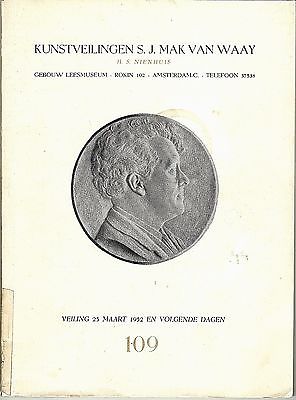
25-03-1952 Auction objects Willem Mengelberg (1871-1951). Catalogue 109 of S.J. Mak van Waay. Rokin 102, Amsterdam. Building Leesmuseum.
25-03-1952 Auction objects Willem Mengelberg (1871-1951). Impression.
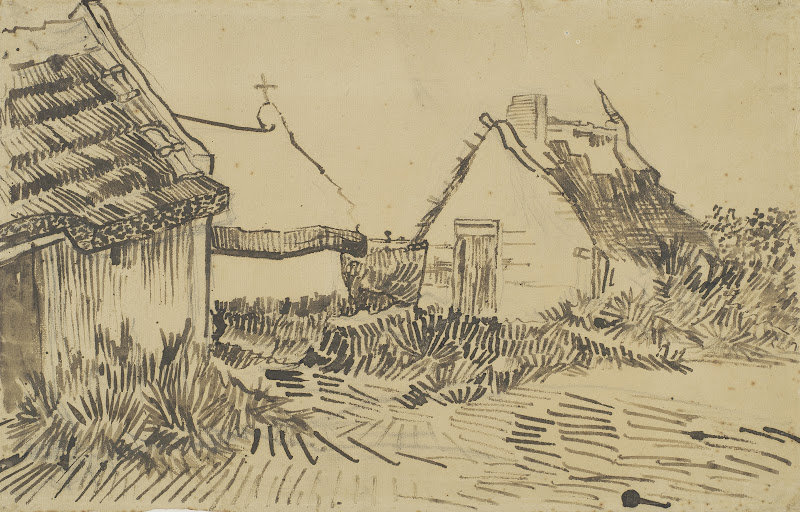
25-03-1952 Auction objects Willem Mengelberg (1871-1951). Vincent van Gogh (1853-1890), Arles, may-june 1888: “Houses in Les Saintes-Maries-de-la-Mer”. Pencil, reed pen and brush in ink, on paper, 30.2 cm x 47.4 cm. Now in the Van Gogh Museum, Amsterdam. Sold for 12.000 guilders (1952).
- Georgine Schwartze (1854-1935): Bronze buste of Gustav Mahler (1860-1911). Probably the one used in the Gustav Mahler Festival Amsterdam 1920.
- Total yield 100.000 guilders (1952).
Chronology
- 1884: Amsterdam. Meeting Johannes Brahms (1833-1897) in Amsterdam.
- 1888: Cologne. Study Conservatory Cologne (Piano and Composition). Pupil of Franz Wullner.
- 1891: First meeting Richard Strauss (1864-1949).
- 1892: Bayreuth. Bayreuther Festspiele. Visitor.
- 1891-1897: Musical Director Luzern.
- 1893: Conductor Luzerner Liedertafel.
- 1894: Compositions by Willem Mengelberg (1871-1951).
- 1895: Luzern. Leaving Luzern.
- 1895: Amsterdam. Debut Amsterdam Royal Concertgebouw and Amsterdam Royal Concertgebouw Orchestra (RCO).
- 1897: Bayreuth. Bayreuther Festspiele. Visitor. 02-08 until 05-08-1897 Ring and 08-08-1897 Parsifal.
- 1898: Bergen.
- 1898: Meeting Mathilde Mengelberg-Wubbe (1875-1943)
- 1899: Amsterdam. Performance of novelties like Richard Strauss (1864-1949)‘s Till Eulenspiegel and Ein Heldenleben in Amsterdam.
- 1899: Amsterdam. Started the tradition of playing Johan Sebastian Bach (1685-1750)‘s St. Matthew Passion on Good Friday in the Amsterdam Royal Concertgebouw. With the Toonkunst choir.
- 1900: Amsterdam. Hendrik Jan de Marez Oyens (1843-1911) had a banking firm en did Mengelbergs finance. The fiancial postion of Mengelberg was weak.
- 1900: Engagement and marriage Mathilde Mengelberg-Wubbe (1875-1943) (June). Hendrik Jan de Marez Oyens (1843-1911) and Charles Ernest Henri Boissevain (1868-1940) best men.
- 1900: Germany, Switzerland: Honeymoon.
- 1900: Brussels.
- 1901: For the first time seen a Gustav Mahler (1860-1911) score.
- 1901: Liege.
- 1902: Krefeld. Richard Strauss (1864-1949) invited the Amsterdam Royal Concertgebouw Orchestra (RCO) to Krefeld. See Willem Hutschenruyter (1863-1950).
- 1902: Summer: For the first time seen score of Symphony No. 1 and Symphony No. 2.
- 1902: Krefeld, 09-06-1902 First meeting Gustav Mahler (1860-1911) and Willem Mengelberg (1871-1951). 1902 Concert Krefeld 09-06-1902 – Symphony No. 3 (Premiere). Introduction by Richard Strauss (1864-1949). Willem Mengelberg (1871-1951) invited Gustav Mahler (1860-1911) to conduct Symphony No. 3 in Amsterdam.
- 1902: Argument with Cosima Wagner (1837-1930) because he did not ask her permission to perform Parsifal in Amsterdam.
- 1902: 20-12-1902 and 21-12-1902 Performance of Parsifal with Betty Frank (1864-0000) as Kundra. Amsterdam Royal Concertgebouw Orchestra (RCO) conducted by Willem Mengelberg (1871-1951) She had a love affair with Gustav Mahler in Year 1885.
- 1902: Dutch Music Festival.
- 1903: Amsterdam. Gustav Mahler himself in the Netherlands (1903, 1904, 1906, 1909 and 1910).
- 1903: Amsterdam, London. Richard Strauss (1864-1949) Festival in London with the Amsterdam Royal Concertgebouw Orchestra (RCO).
- 1904: Amsterdam. Gustav Mahler himself in the Netherlands (1903, 1904, 1906, 1909 and 1910).
- 1904: Take-off career.
- 1904: Contact with Henry Wolfsohn and Hugo Gorlitz about a career in America.
- 1905: Berlin. Meeting with Ferruccio Busoni (1866-1924) in Berlin.
- 1905: Vienna. Meeting with Gustav Mahler (1860-1911) in Vienna (06-1905).
- 1905: New York, Frankfurt, Brussels, Amsterdam, Paris, Italy and Russia. Visit to the Boston Symphony Orchestra (BSO).
- 1905: Letter by Gustav Mahler (1860-1911) to recommend Willem Mengelberg (1871-1951) to the Boston Symphony Orchestra (BSO). (06-1905)
- 1905: Amsterdam. Dutch Music Festival (Nederlands/Nederlandsch Muziekfeest). Dutch composers.
- 1906: Amsterdam. Gustav Mahler himself in the Netherlands (1903, 1904, 1906, 1909 and 1910).
- 1906: Moors between Hilversum and Laren. Photos.
- 1906: Zuiderzee. Photos.
- 1906: Dresden. Music Festival Dresden.
- 1906: Essen. 1906 Concert Essen 27-05-1906 – Symphony No. 6 (Premiere). First meeting with Alma Mahler (1879-1964).
- 1906: Composition Rembrandtfeier, Honderdguldenprent in the atmosphere of Gustav Mahler (1860-1911).
- 1906: Mahler’s help in searching for a flutist, horn player, trumpet player and second conductor.
- 1907: Frankfurt. Museum Concert Frankfurt (Museumgesellschaft). Success.
- 1907: Antwerp, Brussels, Paris, Munich. With the Amsterdam Royal Concertgebouw Orchestra (RCO).
- 1907: Dresden. Meeting with Marion von Weber-Schwabe (1856-1931) (baroness, Baronin) in Dresden. With Max Schilling.
- 1908: Mahler talked again with Mengelberg about the vacancy in Boston. Mahler was in New York at the time.
- 1908: Frankfurt. Work by Anton Bruckner (1824-1896).
- 1908: Brussels, Paris, Rome, Bologna.
- 1909: Amsterdam. Gustav Mahler himself in the Netherlands (1903, 1904, 1906, 1909 and 1910).
- 1909: Moscow, St Petersburg, Rome, Milan, Napels.
- 1910: Rome (meeting Arturo Toscanini (1867-1957)), Milan.
- 1910: Moscow, St Petersburg. Meeting with the brother of Pjotr Iljitsj Tchaikovsky (1840-1893). (or 1909?)
- 1911: Argument with the Board of the Amsterdam Royal Concertgebouw Orchestra (RCO) about the priority between Amsterdam and Frankfurt.
- 1911: Brussels, Napels, Turin, St Petersburg, Moscow.
- 1912: London, Leipzig, Frankfurt, Berlin, Liverpool.
- 1912: Amsterdam. Dutch Music Festival (Nederlands/Nederlandsch Muziekfeest). Dutch composers.
- 1913: Mengelberg becomes more autocratic.
- 1913: St Petersburg, Morscow, London, Paris, Berlin
- 1914: Graubunden. Willem Mengelberg (1871-1951) had a villa built in Graubunden, Switzerland.
- 1914: London, Rome.
- 1914: First World War. Mengelberg in Chasa Mengelberg, Switzerland. The arguments for not returning in time to the Netherlands were openly questioned. Although the Netherland were neutral Mengelberg wanted to play pro-German music.
- 1915: Mengelberg’s sense of duty towards Frankfurt was not appreciated in the Netherlands. Arrival Rudolf Mengelberg (1892-1959) in Amsterdam.
- 1915: Contact Alma Mahler (1879-1964) about concerts in Vienna.
- 1917: Vienna with the Vienna Philharmonic Orchestra (VPO). Das Lied von der Erde. (Durigo and Urlus). 30-12-1917. Alma Mahler gave Willem Mengelberg (1871-1951) a manuscript-partiture and a manuscript-particel from Lied 6: Der Abschied (last movement of Das Lied von der Erde). The manuscripts were packed in a beaFutiful cassette given by Alma Mahler (1879-1964) in gratitude to the conductor. On the inside of the cover she wrote a flattering mission: “Dem Freunde Gustav Mahler / dem herrlichsten Interpreten seiner Werke / Willem Mengelberg / Der Abschied (Lied von der Erde)/ Partitur und Clavierauszug / am 30 dec. 1917 von Alma Mahler gegeben” which indicates how closely Mengelberg came to Mahlers musical intentions. From all of Mahler’s work, Mengelberg had with Das Lied von der Erde the most intense band and he reached a definite highlight with his interpretations.
- 1917: Richard Specht (1870-1932) dedicated his biography of Gustav Mahler to Willem Mengelberg (1871-1951).
- 1918: Vienna with the Vienna Philharmonic Orchestra (VPO). 01-01-1919 Symphony No. 4 in Vienna. (Gertrude Forstel (1880-1950)).
- 1919: Paris. Gabriel Pierne (1863-1937).
- 1919: Inflammation on his arm. Had to cancel three concerts. A few weeks in a sanatorium in Laag-Soeren.
- 1920: Amsterdam, Gustav Mahler Festival Amsterdam 1920. New York. 25-07-1920 Mengelberg buys Hof Zuort (later called Chasa Mengelberg).
- 1921: Amsterdam, New York, Spain, Italy. 08-01-1922 New York: Mengelberg in the Christian Science Monitor about Mahler: ‘Mahler is the Beethoven of our time’. 18-02-1922 statement repeated in the Musical America. 29-05-1921 Symphony No. 1 in Rome.
- 1921-1944: Performances by Willem Mengelberg in period 1921-1944 locations: Aachen, Amsterdam, Antwerp, Belfast, Berlin, Birmingham, Bologna, Bristol, Brussels, Budapest, Chemnitz, Cluj, Cologne, Copenhagen, Detroit, Dortmund, Dresden, Dublin, Dundee, Dunfermline, Dusseldorf, Edinburgh, Elberfeld, Essen, Florence, Frankfurt, Gelsenkirchen, Geneve, Glasgow, Gottingen, Halle, Hamburg, Hanley, Lausanne, Leicester, Leuna-Merseburg, Liege, Lissabon, London, Lugano, Maagdenburg, Madrid, Mannheim, Middlesborough, Milan, Montreux, Munich, Napels, New York, Newcastle, Nottingham, Nurnberg, Paris, Philadelphia, Potsdam, Prague, Preston, Rochester, Rome, Salzburg, Sheffield, Stockholm, Strasbourgh, Stuttgart, Szeged, Triest,, Turin, Venice, Vienna, Wiesbaden and Zurich.
- 1922: Amsterdam, New York, Hamburg. 19-10-1922 and 20-10-1922 Lied von der Erde in Hamburg. 21-10-1922 Symphony No. 1 in Berlin. 14-04-1922 first recordings with the New York Philharmonic Orchestra (NYPO/NPO). Chasa Mengelberg ready.
- 1923: Amsterdam, New York: According to Samuel Bottenheim (1882-1957), in later years Mengelberg’s secretary and manager, Siegfried Wagner (1869-1930) laid down the old Parsifal cattle at a dinner in New York in 1923. Long before, however, Cosima Wagner (1837-1930) had already attended a concert of Mengelberg in Frankfurt.
- 1924: Amsterdam, New York. New York Philharmonic Orchestra (NYPO/NPO), Paris. Ill. Unsuccessful invitation by Alma Mahler (1879-1964) to conduct the unfinished Symphony No. 10 in New York. 12-10-1924 by Franz Schalk (1863-1931). Igor Stravinsky (1882-1971) in Amsterdam.
- 1925: Amsterdam, New York. New York Philharmonic Orchestra (NYPO/NPO). Visit to Arturo Toscanini (1867-1957) in Bellagio.
- 1926: Amsterdam, New York, Antwerp. New York Philharmonic Orchestra (NYPO/NPO). 17-05-1926 Symphony No. 5 (Adagietto) in Antwerp.
- 1927: Amsterdam, New York, Essen, Dusseldorf. New York Philharmonic Orchestra (NYPO/NPO). 02-05-1927 Symphony No. 4 in Essen. 03-05-1927 Lied von der Erde in Dusseldorf. 04-05-1927 Symphony No. 4 in Duisburg. 05-05-1927 Symphony No. 4 in Cologne. 07-05-1927 Symphony No. 4 in Wiesbaden. 14-05-1927 Symphony No. 4 in Zurich.
- 1928: Amsterdam, New York, Brussels. New York Philharmonic Orchestra (NYPO/NPO). 03-03-1928 Symphony No. 1 in Antwerp. 04-09-1928 Richard Strauss (1864-1949) in Zuort.
- 1929: Amsterdam, New York. New York Philharmonic Orchestra (NYPO/NPO). 23-04-1929 Symphony No. 4 in Dusseldorf. 24-04-1929 Symphony No. 1 in Cologne. 25-04-1929 Symphony No. 1 in Gelsenkirchen. 27-04-1929 Symphony No. 1 in Frankfurt. 30-04-1929 Symphony No. 4 in Hamburg. 01-05-1929 Symphony No. 4 in Berlin (attended by George Szell). 04-05-1929 Symphony No. 4 in Maagdenburg. 24-10-1929 Stock market crash.
- 1930: Amsterdam, New York. New York Philharmonic Orchestra (NYPO/NPO), London, Brussels. Ill. 02-05-1930 Symphony No. 5 in Brussels. Tax issues.
- 1931: London. 29-03-1931 60th birthday in Amstel Hotel. 30-04-1931 Film recordings in Epinay-sur-Seine.
- 1932: London, Dusseldorf. 02-12-1932 Symphony No. 1 in Dusseldorf. 03-12-1932 Symphony No. 1 in Cologne. 04-12-1932 Symphony No. 1 in Dortmund. Tax issues. Living in Amsterdam Amstel Hotel.
- 1933: London, Paris. 08-05-1933 Symphony No. 4 in Paris. Official Swiss. Ill. Tax issues solved. Pro NSDAP, pro Hitler, pro Mussolini. 03-1933
- 1934: Amsterdam, Utrecht, Salzburg. Pierre Monteux ended a ten year period with the Amsterdam Royal Concertgebouw Orchestra (RCO). 21-04-1934 Back in Amsterdam. 03-11-1934 Public rehearsal Symphony No. 4. in Vienna. 04-11-1934 Symphony No. 4 in Vienna in Vienna. 06-11-1934 Party by Alma Mahler (1879-1964) and Franz Werfel (1890-1945) in Vienna. Success. Different from original Mahler performances. 15-11-1934 Symphony No. 4 in Prague. 17-12-1934 Symphony No. 4 in Brussels. Ill.
- 1935: Amsterdam. Dutch Music Festival (Nederlands/Nederlandsch Muziekfeest). Dutch composers. 02-05-1935 until 19-05-1935. On the occasion of the 40-year collaboration of Mengelberg with the Amsterdam Royal Concertgebouw Orchestra (RCO). Performances of Alphons Diepenbrock (1862-1921)‘s Te Deum and Electra (performed by the Diepenbrock daughters in the small hall). Afterwards a visit to House Diepenbrock. Willem Mengelberg (1871-1951) had not been there since 1921 because of an argument. 11-05-1935. Musical homage to Willem Mengelberg, standing on the platform of the Amsterdam Amstel Hotel. Dinner in Amstel Hotel. Awards. One of the presents was a car (Minerva 40 C) that replaced the Minerva he got in 1931. Fireworks. Painting made by Antoon van Welie (1866-1956). 10-10-1935 Interview Telegraaf. See picture this page.
- 1936: Berlin. Many concerts in Germany.
- 1936: Amsterdam: Commemorative concerts following the 25th anniversary of Mahler’s death. Klein Mehler Festival. Performed were Symphony No. 2, Symphony No. 4, Symphony No. 5 (Adagietto), Symphony No. 9 and Lieder Eines fahrenden Gesellen. Bruno Walter gave a lecture about Mahler. The two parts of Symphony No. 10 (Purgatorio and Adagio) were not on the program.
- 1937: Amsterdam: 21-11-1937 Symphony No. 4 in Amsterdam. Many Mahler concerts by Mengelberg in Amsterdam.
- 1938: Amsterdam, Dresden, Copenhagen, Florence, Paris. 16-03-1938 Symphony No. 5 (Adagietto) in Florence. 23-03-1938 Symphony No. 5 (Adagietto) in Rome.
- 1938: Amsterdam: 50th Anniversary Amsterdam Royal Concertgebouw. 05-05-1938, 06-05-1938, 08-05-1938 and 10-05-1938 Symphony No. 8 in Amsterdam. Guests were Alma Mahler (1879-1964) and Franz Werfel (1890-1945). A few months later Alma wanted to give her Rodin sculpture to the Concertgebouw. It did not work out. 06-10-1938 New chairs and lighting. Paintings of Mengelberg by Jan Sluijters and Kees van Dongen.
- 1938: Amsterdam: Nomination Eduard van Beinum (1900-1959) and not Bruno Walter (1876-1962).
- 1938: Vienna: Meeting with Paul Stefan (1879-1943) about a visit from Willem Mengelberg (1871-1951) and Max von Schillings (1868-1933) to Marion von Weber-Schwabe (1856-1931) in Year 1907 where he say early compositions of Mahler. Four compositions made before Symphony No. 1.
- 1939: Amsterdam, Dredsen, Budapest.
- 1939: Many Jewish friends and artists wrote to Mengelberg without success to ask for his help.
- 1940: Frankfurt: 05-05-1940 Mengelberg left for Frankfurt. 03-10-1940 Amsterdam concert.
- 1940 World War II. Amsterdam: 10-05-1940 The Netherlands occupied by Germany. Probibition to perform music by Jewish musicians and composers.
- 1940 World War II. Amsterdam: 02-08-1940 Arrival in Amsterdam.
- 1940 World War II. Amsterdam: 10-10-1940 Symphony No. 1 in Amsterdam. Last concert Mengelberg in Amsterdam.
- 1940 World War II. The Hague: 26-10-1940 Symphony No. 1 in The Hague. Last Mahler concert by Willem Mengelberg.
- 1940 World War II. Berlin, Budapest.
- 1941 World War II. Dusseldorf: Contact with Seyss-Inquart. 28-03-1941 40th anniversary. Amster Hotel.
- 1942 World War II. Amsterdam, Salzburg, Paris, Vienna. 01-03-1942 Amsterdam concert. 08-04-1942 Rehearsal and concert with the Amsterdam Royal Concertgebouw Orchestra (RCO) in the Gesellschaft der Musikfreunde. 100 years Vienna Philharmonic Orchestra (VPO). Next day visit with the RCO to Rathaus. Halle.
- 1943 World War II. Amsterdam, Paris. Death Mathilde Mengelberg-Wubbe (1875-1943)
- 1944 World War II. Amsterdam, Paris. Last concert season.
- 1945 World War II.
- 1946: Exclusion by the Netherlands. Switzerland. Appeal.
- 1947: Amsterdam: Lawsuit. Exclusion from Dutch cultural life 1947 until 1951. 1951 would happen to be the year in which he died.
- 1947: Switzerland. Chasa Mengelberg.
- 1948: Switzerland. Chasa Mengelberg.
- 1949: Switzerland. Chasa Mengelberg.
- 1950: Switzerland. Chasa Mengelberg.
- 1951: Switzerland. Chasa Mengelberg. Death Willem Mengelberg (1871-1951).
- 1951: Amsterdam. Amsterdam Royal Concertgebouw Commemoration Willem Mengelberg. Conductor Otto Klemperer (1885-1973).
Legacy
- 1920-2003: Willem Mengelberg Fonds.
- 1952: Stiftung Willem Mengelberg.
- 1952: Auction objects Willem Mengelberg (1871-1951) in the Netherlands in 1952: Auction for 5 days from 25-03-1952 to 30-03-1952 at S.J. Mak van Waay in Amsterdam. Including 145 musical instruments.
- 1953: Chasa Mengelberg to rent for musicians. Many members of the Amsterdam Royal Concertgebouw Orchestra (RCO) and Bernard Haitink (1929) stayed here..
- 1970-2003: Stichting Chasa Mengelberg.
- 1984: Gustav Mahler Manuscript Symphony No. 2: Private sale to Gilbert Kaplan. Sold by Stiftung Willem Mengelberg for maintenance of Chasa Mengelberg.
- 1986: Gustav Mahler Manuscripts Todtenfeier and Lieder eines fahrenden Gesellen, Mozart Aria and Ernest Bloch (1880-1959) Schelomo: Auction Sotheby’s London. Sold by Stiftung Willem Mengelberg.
- 1987: Willem Mengelberg Vereniging.
- 1992: Mengelberg Archive. Consortium of agencies and individuals to secure the Mengelberg Archive.
- 1994: Remaining manuscripts, scores and correspondence bought by Mengelberg Archive. Like Lied 6: Der Abschied (owned by Mengelberg since 1917).
- 2010: Chasa Mengelberg: Sold by Stiftung Willem Mengelberg.
05-09-2001 Luzern: Chief conductor Riccardo Chailly (1953) of the Amsterdam Royal Concertgebouw Orchestra (RCO) puts a wreath on the grave of his predecessor Willem Mengelberg (1871-1951) in Luzern. Mengelberg died half a century ago that year. Mengelberg has been reviled for his uncritical attitude towards the Nazis, but his undisputed artistry is now coming to the fore once again. The Concertgebouw Orchestra played Gustav Mahler’s Symphony No. 2 in Luzern and decided to dedicate this performance to Mengelberg.
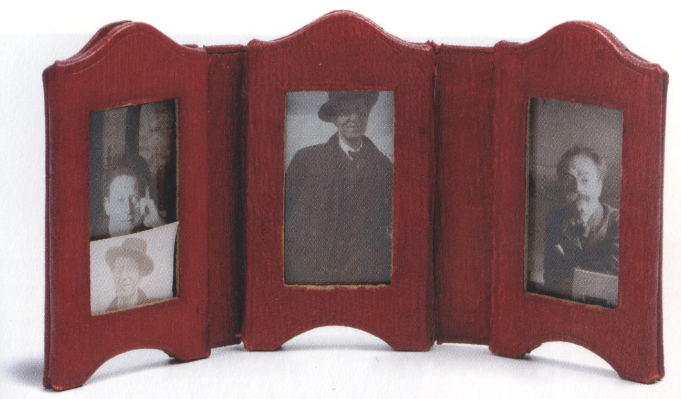
1951. Three friends. Leather photo holder (h 10 x w 20 cm) with the portraits of Willem Mengelberg (1871-1951) (l), Gustav Mahler (1860-1911) (m) and Alphons Diepenbrock (1862-1921) (r). Separately, a picture of Mahler has been inserted. This triptych was on the bedside table at Mengelberg’s bed in his room in Chasa Mengelberg. Source: Archives of Willem Mengelberg, Netherlands Music Institute / The Hague Municipal Archives. Taken from the biography of Willem Mengelberg (part II) by Frits Zwart.
